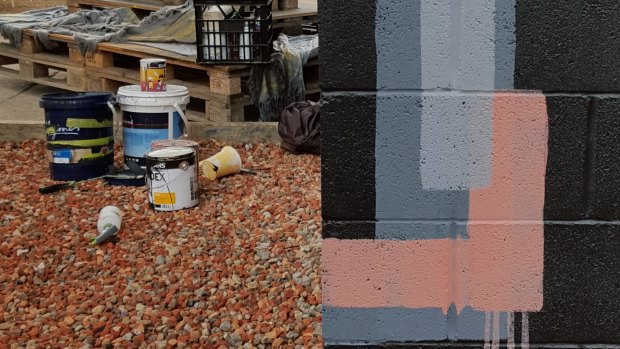This was published 7 years ago
CCAS Braddon has terrific exhibitions by Frazer Bull-Clark, Jason Phu and Byrd
By Peter Haynes
The Big Shave By Frazer Bull-Clark. I haven't made the work yet but I'll be there a week beforehand which should be plenty of time by Jason Phu. # Inurtiacreeps by Byrd. Canberra Contemporary Art Space, 55 Ainslie Avenue, Braddon, Until October 1.
The three exhibitions currently showing at the Canberra Contemporary Art Space are terrific examples of the reason that contemporary art spaces are integral to the ongoing vitality of contemporary visual arts practice in our town (and elsewhere) and a potent reminder to funding bodies of the importance of funding decisions being based on rational and considered decision-making. The exhibitions are "edgy", intelligent and questioning, and while some may not like them they cannot ignore them.

Byrd, #Inurtiacreeps, 2016, work in progress detail at Canberra Contemporary Art Space Braddon.
In Cube Space, Frazer Bull-Clark's The Big Shave (a reference to a film of the same name by Martin Scorsese) is a 9 minute 38 second compendium of images of men shaving or being shaved taken from a range of recent and vintage movies. The list of "stars" appearing under Bull-Clark's razor is long and includes Charlie Chaplin, Buster Keaton, Marlon Brando, Humphrey Bogart, Clint Eastwood and several manifestations of James Bond from Sean Connery to Daniel Craig. It is an extraordinary gamut and while each star's appearance may only be momentary, the artist's skilful editing and choice of inclusions is embracing, sophisticated and captivating. I listed more than 30 with whom I was familiar and while the recognition game is certainly a part of this work it is also much more than that.
The choice of excerpts is not only fun but challenging in its variety and in the different types of masculine personae included. The act of shaving may be innocuous in itself. Bull-Clark does not deny this but hints at a range of readings and meanings that are (often) at play in scenes where shaving or being shaved is involved. The intimacy of the activity in mostly private spaces speaks of the quotidian rituals of masculinity. When others become involved intimacy collides with vulnerability and there is an exquisite tension imbued in scenes where one is being shaved by the other. The notion of the voyeur also arises and the artist's clever and unexpected juxtapositions nicely play with this. The Big Shave offers a lot in its just over nine minutes. I left the room with an image of John Wayne gazing at Dean Martin shaving and any preconceptions left with me.
Jason Phu's I haven't made the work yet but I'll be there a week beforehand which should be plenty of time is a multi-layered work that speaks of cultural collisions, elisions and citations within a 21st-century context set by the artist. The work itself appears unrefined, even sloppy. It is a bit like Robert Rauschenberg's 1955 Bed meets Tracey Emin's late 20th-century work and the resultant convergence is a sort of neo-grunge Dadaist expressionism. I get the feeling that like Rauschenberg, Phu's art is about his life as experienced now and its shoddy immediacy is a close reflection of that. The present work includes canvas sheets, a mattress protector, Buddha heads (smashed), incense, a domestic shrine and text.
The latter in both Chinese and English tells the story of a man whose penis fell into a pond and was eaten by a fish. The story is Chinese and some of the accoutrements that form the work reinforce the overall "Chinese" character. Allusions to Chinese scrolls are a further reinforcement of this. But while Phu may embrace his Chinese origins he expresses them with a language that derives from the spontaneous expressions of contemporary street art found in an Australian context. I haven't made the work yet … may confront or even shock but its blatant immediacy and frankness deserve consideration.
In the Main Space Byrd's #Inurtia documents the means and tools of his practice as both street artist and gallery artist. The artist's means are wherever he finds them and in the context of the gallery each object holds the story of its use and its meaning for the artist in his practice. The centrepiece of the exhibition is a fully scaled cardboard model of the artist's station wagon. It is full of stuff that includes used paint cans, cloths, paint rollers and other tools of his trade. The front of the wagon is full of junk – disused food containers, drink bottles and the like – more stuff that talks of the artist's movements from one site to another in order to find places to situate his art.
The inclusion of wall pieces points to other aspects of his practice. The materials used to create these reinforce the connections within his practice that give it a unity across object, place and site. Byrd does not differentiate between the street, the alley or the gallery wall. Each is simply a place where his art can live. The unity of his art is given expression in the way that the exhibition in the gallery is installed. There are no hierarchies here but rather an aesthetic democracy where each element is an equal contributor to the whole.